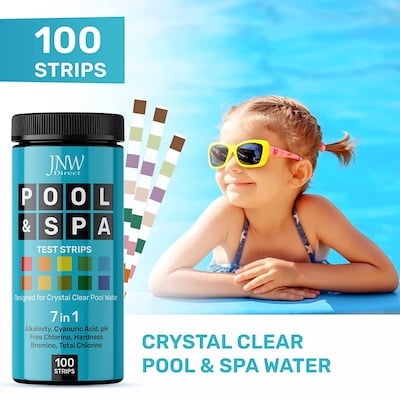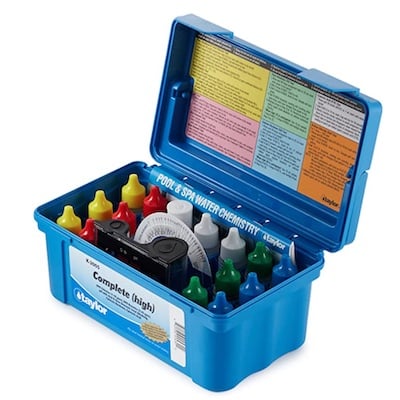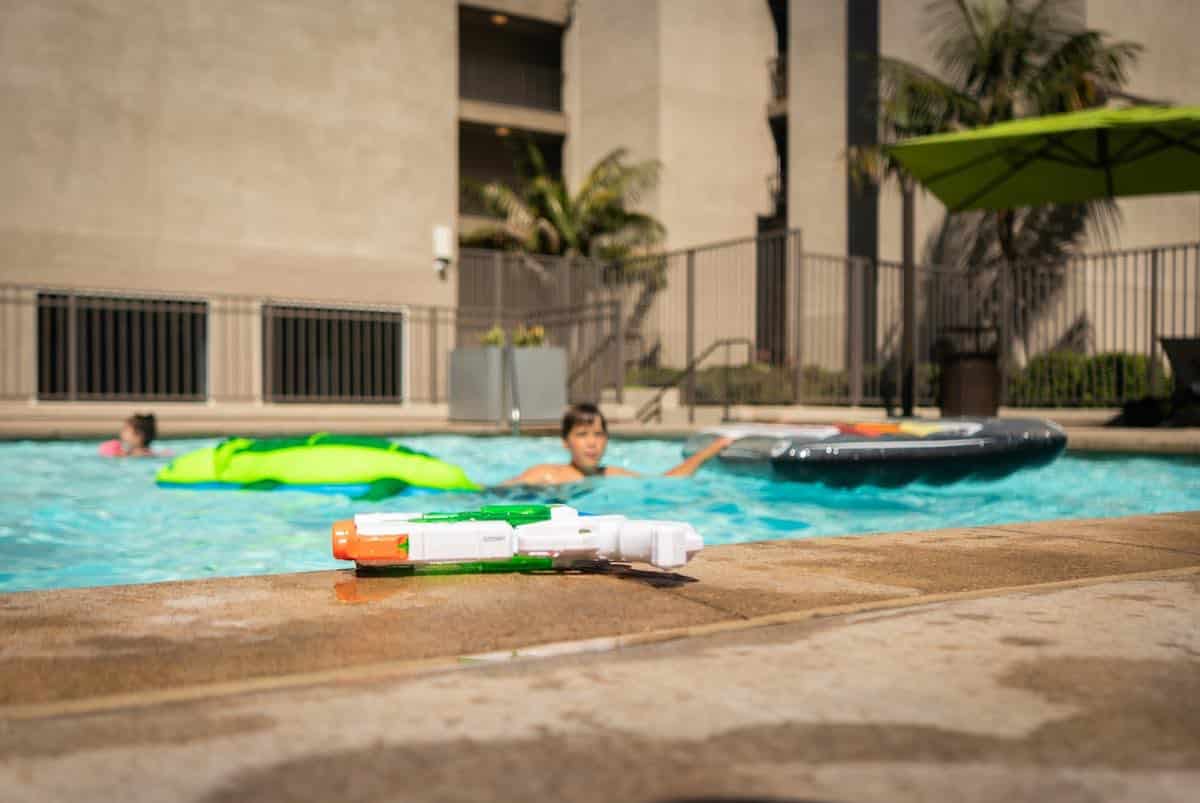Having the perfect pool water requires an understanding of water chemistry — including calcium hardness.
If you swim and find that the water seems quite cloudy and there are bits of sediments on the floor, then you may be dealing with high calcium hardness in your pool.
Today, you’ll be learning tips on lowering (but not by too much!) that hardness level and how to maintain a good amount of calcium in the pool.
What is calcium hardness?
Calcium hardness is basically how hard or soft your pool water is. This is based on how much calcium (a.k.a calcium carbonate) is dissolved in the water.
Getting the hardness levels right is important since too much and too little is bad news for the pool.
Hard pool water
Hard water is when the calcium levels in the pool read above 400 ppm.
Even without testing the swimming pool, you’ll notice that it has cloudy water. The surface of the water may also have white blotchy areas.
Alongside that, the walls may feel like sandpaper, and you might even see sediments settling on the pool floor.
Soft pool water
On the other hand, soft pool water is when calcium levels read below 150 ppm.
Even though it’s called soft pool water, there is nothing soft about it. That’s because it becomes corrosive and attacks pool equipment.
You might notice dissolving tile grout, as well as pitting on the surface of concrete pools. It will corrode metal too!
Overall, leaving soft pool water alone is the first step to shelling out money for expensive repairs.
How to measure the calcium hardness in your pool
There are two ways you can test for calcium hardness levels in the pool:
Calcium hardness test strip
Test strips are easy to use! Just follow these steps:
Time needed: 1 minute
How to measure your pool’s calcium hardness level with test strips
- Get your strip container out
Take a strip from the container. Do it quickly so you don’t expose the other strips to the elements.
- Dip the strip in the water
Dip the strip for 15 seconds at around elbow length in the pool water.
- Take it out and put it down flat
Put the strip on a flat surface that’s not under the sun.
- Check the color of the strip
Compare the strip’s color to the color sample that the strip container comes with.
Take note that these strips can only give you an estimate of the calcium hardness level of your pool.
Our Recommendation: 7-1 Pool Test Kit by JNW Direct

Calcium hardness test kit
These kits are more accurate than the strips.
There isn’t really a general guideline shared by all kits since they all work with different chemicals. As such, you should always follow the instructions with the kit you get.
You can get these as individual kits made specifically for testing calcium hardness.
But there are also more general pool kits that can let you perform a wide range of water tests — including calcium hardness.
Our Recommendation: Taylor K2005 Swimming Pool Test Kit

Image source: Amazon.com.
What is the ideal calcium hardness level?
It depends on the kind of swimming pool you have.
Most pools are made of concrete and plaster. For these, it’s ideal to have 200 to 275 ppm.
But a vinyl or fiberglass pool can operate at lower hardness levels, specifically between 175 and 225 ppm.
How often should I test the calcium hardness?
While pH and alkalinity levels in the pool should be tested weekly, testing for calcium hardness depends on the quality of water your area has.
If your area tends to have hard water, then you should check the pool water every two weeks.
But if your swimming pool has consistently normal calcium hardness levels, then once a month is enough.
How to lower calcium hardness level in swimming pool water
It’s better to address your water hardness BEFORE it gets out of hand.
Once you see signs that your pool calcium level is high, below are some things to try:
1. Drain, then add fresh water
The draining part is essential. Simply adding tap water will not work since water evaporates while calcium does not.
If the pool has calcium levels above the ideal range, you’ll need to drain around one-fourth of the existing pool water.
You can drain using a pool pump to backwash. You can also siphon the water with a hose and drop-in pump.
Before you refill the pool, test your tap water source first. If it has high calcium levels, you can use a hose filter to keep as much excess calcium as you can out of the pool.
Wait for at least six hours for the existing and fresh water to mix before you retest its calcium hardness level.
This option can admittedly get quite expensive — especially if water rates are high in your area.
2. Use a flocculant
If draining sounds too time-consuming and costly, you can use flocculants. Some examples are soda ash and caustic soda.
Flocculants are additives that will cause free-floating minerals to clump together. This makes them easier to vacuum or filter out!
To assist the flocculant, you can vacuum the pool surfaces to free up the calcium deposits stuck on them.
But most flocculants work assuming that the calcium carbonate isn’t dissolved in the water.
However, the pump and filter should be turned off when you use a flocculant. If the solution gets into the filter, you’ll need to replace it.
Unfortunately, that means a flocculant isn’t an option if you have a cartridge filter.
Soda ash is an interesting case — it’s very water-soluble and raises the pH of the pool. This causes the dissolved calcium to precipitate.
It will result in milky pool water, but you’ll at least be able to filter it — although the process may take days or even weeks.
3. Try an acid
Using acid actually won’t reduce the hardness of existing water. Instead, the acid will raise the saturation level of the swimming pool water. This can help keep your water balanced.
But this option should be a last resort.
That’s because acid messes with the pool chemistry, such as total alkalinity and chlorine levels.
You should ideally first consult a pool service provider for advice on this. If they give you the go-signal, muriatic acid and dry acid are two common chemicals for the job.
How to increase calcium hardness levels in a swimming pool
Increasing calcium in swimming pools is easy!
All you need to do is put some calcium hardness increaser (usually calcium chloride). Make sure to follow the instructions for the best results.
You can get these hardness increasers at most swimming pool retailers.
Our Pick: Pool Mate Swimming Pool Calcium Hardness Increaser
Pool Mate Calcium Plus is used to raise calcium hardness levels when measures drop below the recommended range of 200-400 ppm.
If calcium hardness levels are too low the “soft water” will corrode pool equipment, etch pool plaster and may cause metallic stains.
How to manage and maintain your swimming pool’s calcium hardness levels
Once your pool has the right calcium hardness level, you should know how to keep it properly balanced. Here are ways to do so:
- Keep the swimming pool clean – Brush pool surfaces, vacuum the pool, and backwash the filter. This prevents excessive calcium from building up.
- Balance the pool chemistry – The first thing to balance is alkalinity, followed by the pH, and lastly, calcium hardness. But since these are all interconnected, maintaining every aspect is important for the pool.
- Test the water regularly – This immediately tells you if you have too little or too much calcium in the pool.
- Act early – You should act immediately when you see signs of extremely high or low calcium hardness. Doing so will prevent your pool water from getting more whacked out of balance than it already is.
Frequently Asked Questions about calcium levels in your pool
Now that you know why you should balance calcium levels in your pool, let’s answer a few more related questions:
With water chemistry, everything gets affected if even just one aspect isn’t in balance. If something’s wrong with the pool’s chlorine, pH, or total alkalinity, then you’ll likely have other things to deal with.
Water temperature also plays a part, and the higher the temperature, the easier it will be to get rid of the excess calcium. A pool shock will also throw your pool’s calcium levels out of balance.
High pool calcium levels will leave deposits of the mineral everywhere — from the pool walls to the inside of your filters. You also get free-floating calcium that the water can’t dissolve anymore. Another troublesome effect of high calcium is that other chemicals used to adjust pH levels, chlorine, and other aspects of the pool will be less effective.
As the name suggests, it helps in lowering the calcium level in the pool. However, this is a temporary solution that will last only four to six weeks. The way this works is that these decreasers will temporarily bind the calcium. Then after six weeks, it breaks down, releasing the calcium back into the pool.
Baking soda, or sodium bicarbonate, actually doesn’t do anything for your pool’s calcium hardness. Instead, it’s better for maintaining good pH and alkalinity levels.
A too-low calcium level for the swimming pool water is probably more trouble than high levels. Since the water lacks calcium, it will look for it somewhere else. That’s why it will corrode any metal parts in your pool or dissolve the concrete.
Conclusion
Managing and maintaining a pool’s calcium hardness levels can be confusing at first.
Fortunately — from testing the pool water to using flocculants — there’s much you can do to keep it at the right level.
Once pool owners master the art of water chemistry, they’ll have a pool you can swim in all season long.

1 comment